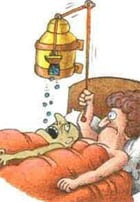Is hammering the brain’s desire circuitry a good idea?
 A drug that makes you not only able but eager and willing isn’t going to remain the exclusive property of the severely impaired. As with Viagra, there will be extensive off-label use.—Julian Dibbell, The Observer
A drug that makes you not only able but eager and willing isn’t going to remain the exclusive property of the severely impaired. As with Viagra, there will be extensive off-label use.—Julian Dibbell, The Observer
The “orgasm pill” is back on track and chugging our way. See ‘Women’s Viagra’ Targets Her … Brain. The drug, which alters brain chemistry to “unleash women’s desire,” works by “triggering the production of dopamine, [and] has the potential to revolutionize sexual medicine as much as Viagra did.”
Viagra, of course, targets blood vessels (to produce erections), not brains. It doesn’t directly initiate desire or orgasm. In many men, the feeling of an erection triggers desire, just as visual cues do. But for others, and for women, Viagra doesn’t cut it. Hence the drug-makers’ longing to find a bigger hammer for anyone who would like more orgasms than they’re having at present. (Keep in mind that this group also includes those who have over-stimulated and desensitized themselves with too much orgasm. Women often report that vibrator use desensitizes their genitals, and many frequent porn users report concerns about their sexual responsiveness during sex with a partner.)
As portrayed in the documentary “Super Size Me,” when big business caters to the profitable cravings of the human reward circuitry, we should anticipate heavy marketing and lobbying of the addictive and the unhealthy. As a culture we can become so goal-oriented toward short-term buzzes that we lose sight of both the costs of our new habits and our larger goals (such as connection with others).
So far, the furor about this drug swirls around the narrow conceptual debate “Is it appropriate to medicalize women’s sexual responsiveness?” That is a worthy dialogue. Yet a greater peril lurks: This drug works by targeting the user’s reward circuitry, the seat of desire—regardless of gender. It does so by raising dopamine (the “I gotta have it!” neurochemical). This should sound loud warning bells. After all, women’s brains are sensitive to overstimulation, just as men’s are.
Already other drugs that imitate dopamine—given to target the brain’s muscle control centers in Parkinson’s patients and restless leg syndrome sufferers—have unexpectedly thrown some patients’ reward circuitry completely out of kilter, producing startling and destructive behaviors. From deep in the brain’s primitive limbic system, our reward circuitry not only regulates sexual desire; it is also a crucial component of our inner compass—the source of our gut feelings and proclivities. When it’s off, so is our judgment. And with extra dopamine in the mix, it can be way off.
In 2005, Mayo Clinic reported that drugs for Parkinson’s, which flood dopamine receptors (many of which are concentrated in the reward circuitry of the brain), can amp up patients’ appetites for sex, food, alcohol and gambling. In fact, one out of ten Scottish patients taking dopamine-elevating drugs developed serious gambling addictions. Also consider the experience of a Frenchman who was prescribed this type of drug. A court awarded him a large settlement, ruling that the drug had turned him into a gambler and thief, with compulsive homosexual urges (he was straight when not on the dopamine meds). Similarly, after years of uneventful heterosexuality, an elderly Parkinson’s patient began wearing his deceased wife’s clothing. The urge disappeared when his meds were changed.
Sound exaggerated? Excess dopamine is associated with psychosis, compulsions, fetishes, schizophrenia and addictions. Said a Mayo spokesperson, “When our neurologists tapered the patients off the medication, several reported a dramatic resolution of their problem. One patient said it was like a light switch going off.” Were former president Clinton or Mark Sanford treated for restless legs?
Now, imagine the possible side effects of a drug intended to goose the reward circuitry of the brain. Dopamine surges in anticipation of pleasurable and risky behaviors, which is why the drug raises dopamine levels.
Yet in the long run, too much dopamine can cause dopamine dysregulation and distressing mood swings—both highs and lows. That’s right. Excess dopamine can lead to chronic low dopamine. The brain’s reward circuitry is finely tuned and quite plastic. Addiction research reveals that if we flood it with dopamine (as cocaine users do), it begins to recalibrate itself to cope with excess.
Just as you might close windows when a thunderstorm rolls in, your reward circuitry down-regulates the receptors for dopamine on key nerve cells after over-stimulation. Especially with repeated episodes, the reward circuitry assumes that another “storm” is on the way, so it may not return to its usual configuration right away. It becomes desensitized. (Parkinson’s drugs also tend to lose their effectiveness over time.)
The result of down-regulation? Normal levels of dopamine won’t trigger those subtle feelings of optimism and anticipation that make arising in the morning an attractive proposition. Such sluggishness is a hangover, but it’s also withdrawal. It’s normal to feel rotten while our brain recalibrates so it can, once again, respond normally to dopamine.
Meanwhile, we can become so desperate to “feel right,” that we may reach for any of the many stimulating activities and substances that goose dopamine: drugs, alcohol, impulsive spending, junk food, Internet porn, gambling, engaging in “forbidden” sex, and so forth. Alas, more stimulation can cause further down-regulation—and an even stronger urge for relief. In short, dopamine lows, just like dopamine highs, can drive compulsive behaviors.
This may be why “Depression is strongly linked to high-risk behavior, including drug use, alcoholism, and risky sex.” Some assume that depression leads to acting out, but it’s possible that over-stimulation leads to depression (chronic low dopamine), followed by risky attempts to self-medicate by seeking dopamine surges.
Apart from that risk, fostering addiction in orgasm lovers could provide a secondary bonanza for drug companies. They are already testing “anti-addiction” pharmaceuticals that manipulate the reward circuitry of the brain by…you guessed it…blocking the effects of dopamine. Trials have caused some patients severe depression and even resulted in suicide. And what do you take if you’re not orgasming as easily as you like, but also have an addiction??
 Perhaps it’s apparent that jacking up dopamine to tinker with sex drive could swiftly create all kinds of unwanted repercussions. Worse yet, patients will be unlikely to associate their symptoms with a prescribed orgasm pill, as the results may show up outside the bedroom. For example, diagnosed sex addicts report a high incidence of co-morbidity, that is, addictions to additional substances or activities, such as alcohol, gambling or drugs. Scientists have also shown that rodents who have sex are noticeably more susceptible to substance addiction than virgin rodents. Third, sexually active teens tend to use drugs and alcohol more.
Perhaps it’s apparent that jacking up dopamine to tinker with sex drive could swiftly create all kinds of unwanted repercussions. Worse yet, patients will be unlikely to associate their symptoms with a prescribed orgasm pill, as the results may show up outside the bedroom. For example, diagnosed sex addicts report a high incidence of co-morbidity, that is, addictions to additional substances or activities, such as alcohol, gambling or drugs. Scientists have also shown that rodents who have sex are noticeably more susceptible to substance addiction than virgin rodents. Third, sexually active teens tend to use drugs and alcohol more.
America’s experience with cigarettes and fast food suggests that humans are very good at researching and exploiting what excites the reward circuitry of the brain, and very bad at acknowledging the societal ills and addictions that follow. Reducing sexual desire to the status and profitability of fast food poses very real problems. Dopamine dysregulation is but one. Artficially hammering our sexual desire may actually discourage us from learning to tap its full potential for health and happiness. Strange as it may seem, accelerating sexual satiety with more orgasm will not necessarily improve romances. It may, in fact, speed up the Coolidge effect (habituation between mates).
Let’s ask more questions before ingesting drugs that amp up the brain circuitry that drives both sexual desire and addiction.